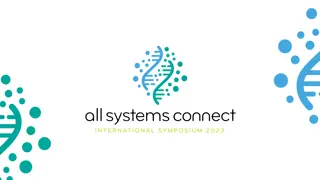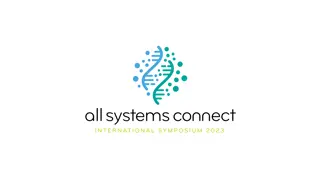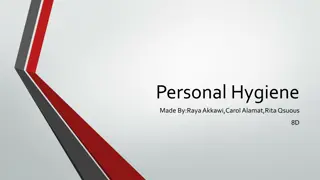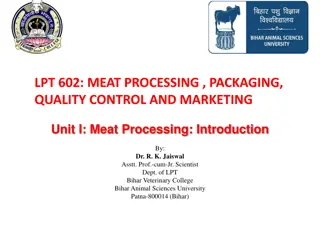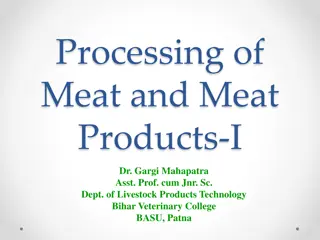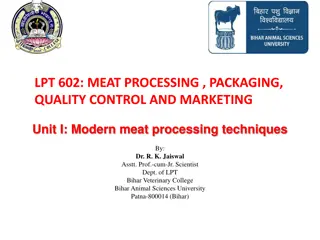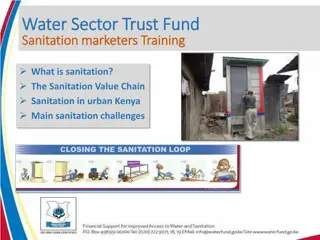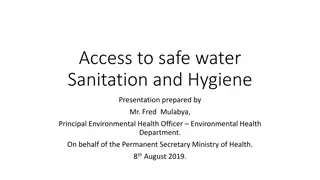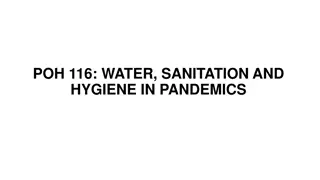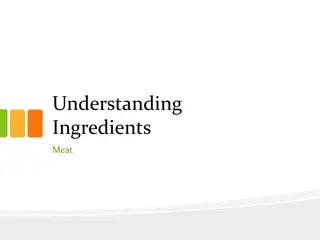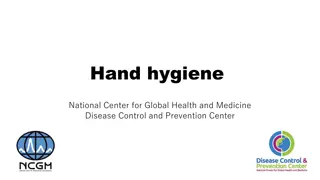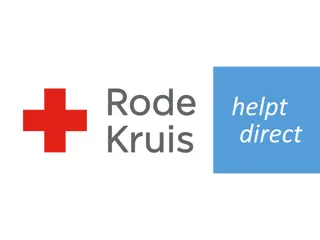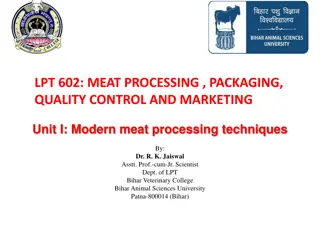Importance of Meat Hygiene and Sanitation in the Meat Industry
Meat hygiene is essential to ensure the safety and suitability of meat for consumers. It involves implementing specific standards and regulatory actions to maintain cleanliness and prevent contamination at all stages of production. Proper cleaning and sanitization practices, adherence to legal standards, and principles of meat hygiene, such as preventing microbial contamination, are crucial in maintaining food safety. Control measures like Good Hygienic Practices (GHP) and Hazard Analysis and Critical Control Point (HACCP) schemes are adopted to ensure hygiene in meat processing.
Download Presentation

Please find below an Image/Link to download the presentation.
The content on the website is provided AS IS for your information and personal use only. It may not be sold, licensed, or shared on other websites without obtaining consent from the author. Download presentation by click this link. If you encounter any issues during the download, it is possible that the publisher has removed the file from their server.
E N D
Presentation Transcript
MEAT HYGIENE AND SANITATION IN MEAT AND POULTRY INDUSTRY Dr. R. K. Jaiswal Asstt. Prof.-cum-Jr. Scientist Dept. of Livestock Products Technology Bihar Veterinary College Bihar Animal Sciences University Patna-800014 (Bihar)
Meat Hygiene Meat Hygiene refers to a set of activities that require the implementation of specific standards, codes of practices and regulatory action by the competent authority to ensure safety and suitability of the meat the consumers eat. Hygiene requirements are to be met at different stages of production, processing and transportation and must include hygiene of personnel, slaughter & meat processing equipment's and environment.
To ensure this, proper cleaning and sanitization practices are to be followed by plant personnel and should include disinfection of meat plant premises, equipments and storage area. Failure in maintaining meat hygiene may pose serious public health hazards and therefore evaluation of meat for meat borne pathogens which can cause diseases of public health importance is very important. Food Safety and Standards (Food Products Standards and Food Additives) Regulations, 2011 also warrant that every product being sold in the Indian market must meet/conform to legal standards of quality.
Principles of meat hygiene Prevention of microbial contamination during meat product manufacture by adopting proper cleaning and sanitation practices. Minimization of microbial growth in meat products by storing them at a low temperature. Reduction or elimination of the risk of microbial contamination by applying treatment and packaging systems at the final processing stage. suitable heat
Control measures Two useful schemes are usually adapted at various levels of meat production: Good Hygienic Practices (GHP) Hazard Analysis and Critical Control Point (HACCP) Scheme.
Good hygienic practices in meat processing Personnel hygiene Hygiene during meat processing Hygiene of meat processing premises (design and construction) Equipment hygiene
Hazard analysis and critical control point scheme (HACCP) HACCP are factory and product specific Prevent, detect, control and/or reduce to safe levels of accidentally occurring hazards to consumers health HACCP schemes serve as additional alarm systems in the interest of consumer protection to prevent such problems occurring. In case potential hazards should occur, they can be detected, contained or eliminated at any stage.
Cleaning and sanitation Generally cleaning refers to removal of visible, physical/chemical dirt and to some extent bacteria from the equipment surfaces, sometime from products itself and from the processing environment. On the contrary, sanitization term is used with disinfection of the product or product contact surfaces by all killing spoilage and pathogenic microorganisms in order to avoid all possible risks of microbial contamination. Inactivation of microorganisms requires antimicrobial treatments, carried out in food industries through hot water or steam or through the application of disinfectants or sanitizers.
Cleaning procedures The first step in floor and equipment cleaning is to physically remove scrap, i.e. coarse solid particles, with a dry brush or broom and shovel. This is usually referred to as dry cleaning . Wet cleaning is followed after removal of physical scrap material. Wet cleaning could be done manually or by using high pressure nozzles. However, this would require water in sufficient quantities.
Common detergents & sanitizers used in meat industry 1. Alkalies: a) Sodium hydroxide b) Sodium carbonate c) Sodium bicarbonate d) Sodium silicates e) Sodium phosphates 2. Acids: a) Nitric Acid b) Sulphuric Acid c) Hydrochloric Acid d) Phosphoric Acid e) Acetic Acid
3. Complex Phosphates: a) Tetra sod. pyrophosphate b) Sod. tripolyphosphate c) Sod. tetraphosphate d) Sod. Hexametaphosphate 4. Chelating Agents: EDTA (Ethylene diamine tetra acetic acid) 5. Wetting Agents: a) Anionic (sod. salt of various complex organic materials b) Non ionic e.g. teepol
Disinfection techniques The elimination of microorganisms is achieved through disinfection, either by using 1. Hot water (or better steam) 2. Chemical disinfectants
Disinfectants for the meat industry (i) Chlorine containing compounds e.g. Na/Ca hypochlorite or chlorine gas, has a corroding effect on equipment. (ii) Aldehydes (used in animal production, e.g. Formaldedyde) Phenoles / Kresols (used in medicine, households Alcohols (used in medicine, e.g. skin) Alkalines (pH 10 or higher) (e.g. NaOH, used in animal production) Acids (some organic acids used in food industries).
Quaternary ammonium compounds Amphotensids (used in food industries, as not corrosive) Low efficiency on spores. They have effect on cell walls, not corrosive, odourless, additional cleaning properties (surfactant) (iii) Oxygen releasing compounds e.g. Peroxide compounds (H2O2) Per-acetic acid (use in food industries). Penetrate into cells, good effect on all microorganisms including on spores and virus, odourless, may be corrosive in concentrations >1%
Cleaning and disinfection (sanitation) schemes Several daily disinfections (by hot water or chemicals) are necessary for hand tools, meat saws and cutting boards. Daily disinfection is useful for dismantled equipment such as parts of grinders, fillers, stuffers, etc. Disinfection once a week is recommended for other equipment and floors and walls of processing and chilling rooms.



